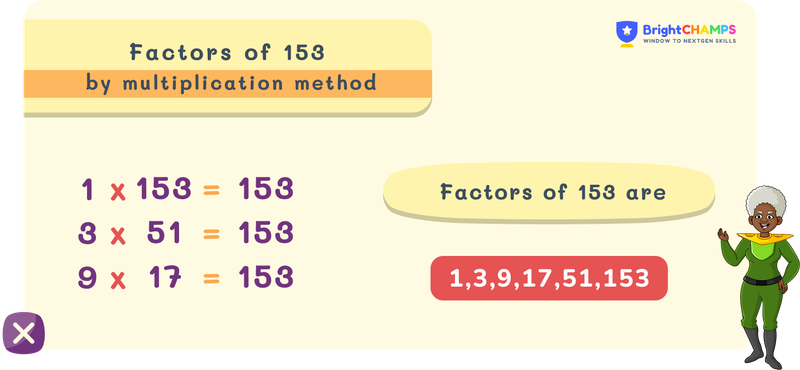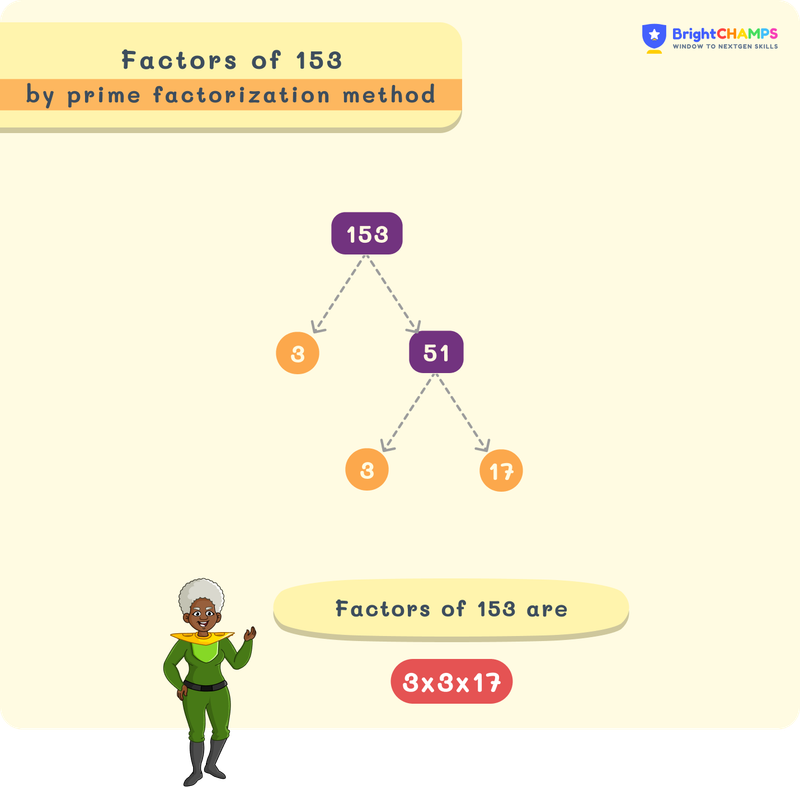Summarize this article:
 379 Learners
379 LearnersLast updated on August 5, 2025
Factors of 153

Factors of any number are the dividers or multipliers that can divide the number fully and can be multiplied together to produce the given product, 153. Do you know, factors form the basic approach to solve some general mathematical procedures? This article will give you the insights of factors of 153.

How to Find the Factors of 153
For finding factors of 153, we will be learning these below-mentioned methods:
- Multiplication Method
- Division Method
- Prime Factor and Prime Factorization
- Factor Tree

Finding Factors using Multiplication Methods
This particular method often finds the pair of factors which, on multiplication together, produces 153.
Let us find the pairs which, on multiplication, yields 153.
1×153=153
3×51=153
9×17=153

So, factors of 153 are: 1,3,9,17,51, and 153.

Finding Factors using Division Method
The division method finds the factors that evenly divides the given number 153. In this process, we have to divide 153 by all possible natural numbers less than 153 and check.
1,3,9,17,51, and 153 are the only factors that the number 153 has. So to verify the factors of 153 using the division method, we just need to divide 153 by each factor.
153/1 =153
153/3=51
153/9=17
153/17=9
153/51=3
153/153=1


Prime Factors and Prime Factorization
Prime Factorization is the easiest process to find prime factors. It decomposes 153 into a product of its prime integers.
Prime Factors of 153: 3,17.
Prime Factorization of 153: 32×17

Factor tree
The number 153 is written on top and two branches are extended.
Fill in those branches with a factor pair of the number above, i.e., 153.
Continue this process until each branch ends with a prime factor (number).
The first two branches of the factor tree of 153 are 9 and 17. Similarly, for 9, we end up having two branches, each with prime factor 3.

Factor Pairs
- Positive pair factors: (1,153), (3,51), (9,17)
- Negative pair factors: (-1,-153), (-3,-51), (-9,-17).

Common Mistakes and How to Avoid Them in Factors of 153
Solving problems based on factors can, sometimes, lead to misconceptions among children. Let us check what the common errors are and how to avoid them.

Factors of 145 Examples

Problem 1
A man has 153 shirts and 51 ties. He wants to divide them equally among some poor people. What is the maximum number of people he can distribute?

Number of shirts: 153
Number of ties: 51
Factors of 153: 1,3,9,17,51,153
Factors of 51: 1,3,17
Common factors of 51 and 153: 1,3,17
Greatest common factor of 51 and 153: 17
So, there will be 17 people for distribution.
Answer: 17 people
Explanation
To divide equally, the maximum number of people can be found through the Greatest Common Factor. Here, we found the GCF, which is the answer.

Problem 2
Two airplanes leave the airport at the same time. One leaves every 17 hours and the other every 51 hours. When will they leave together again?

Time-lapse of the 1st airplane: 17 hours
Time-lapse of the 2nd airplane: 51 hours
Prime factorization of 17:17×1
Prime factorization of 51: 3×17
LCM of 17 and 51: 17×3 = 51.
Both the airplanes will meet each other after 51 hours.
Answer: 51 hours
Explanation
To find the time again when two airplanes will meet, we have to find the LCM of the two given time-lapses. So, did prime factorization of both 17 and 51. The LCM is the product of the highest power of each factor.

Problem 3
Find the GCF of 153 and 51

Factors of 153: 1,3,9,17,51,153
Factors of 51 : 1,3,17,51
Common factors of 153 and 51: 1, 3,17, 51
So, the Greatest Common Factor of 153 and 51 is 51.
Answer: 51
Explanation
We first listed out the factors of 153 and 51 and then found the common factors and then identified the greatest common factor from the common list.

Problem 4
Find the smallest number that is divisible by 3,9,17 and 51.

Prime factorization of 3: 3×1.
Prime factorization of 9: 32
Prime factorization of 17: 17×1
Prime factorization of 51: 3×17
LCM of 3,9,17 and 51: 3×17= 51
Answer: 51 is the smallest number which is divisible by 3,9,17,51.
Explanation
To find the smallest number which is divisible by 3,9,17,51, we need to find the LCM of these numbers.

Problem 5
Find the LCM of 153 and 150

Prime factorization of 153: 32×17.
Prime factorization of 150: 52×2×3
LCM of 150 and 153: 32×2×52×17 = 7650.
Answer: 7650
Explanation
Did prime factorization of both 150 and 153. The LCM is the product of the highest power of each factor.


FAQs on Factors of 153
1.What are the multiples of 153?
2.Is 153 divisible by 7?
3.What is the GCF of 153 and 27?
4.What are co-prime numbers?
5.What is the LCM of 153 and 145?
6.How can children in Thailand use numbers in everyday life to understand Factors of 153?
7.What are some fun ways kids in Thailand can practice Factors of 153 with numbers?
8.What role do numbers and Factors of 153 play in helping children in Thailand develop problem-solving skills?
9.How can families in Thailand create number-rich environments to improve Factors of 153 skills?

Important Glossaries for Factors of 153
- Multipliers - Number which multiplies or a number by which another number is multiplied.
- Dividers - A number that divides.
- Prime Factorization - It involves factoring the number into its prime factors.
- Prime factors - These are the prime numbers which on multiplication together results into the original number whose prime factors are to be obtained.
- Composite numbers - These are numbers having more than two factors.
- Multiple - It is a product of the given number and any other integer.

Explore More numbers
![Important Math Links Icon]() Previous to Factors of 153
Previous to Factors of 153
![Important Math Links Icon]() Next to Factors of 153
Next to Factors of 153

About BrightChamps in Thailand


Hiralee Lalitkumar Makwana
About the Author
Hiralee Lalitkumar Makwana has almost two years of teaching experience. She is a number ninja as she loves numbers. Her interest in numbers can be seen in the way she cracks math puzzles and hidden patterns.
Fun Fact
: She loves to read number jokes and games.




